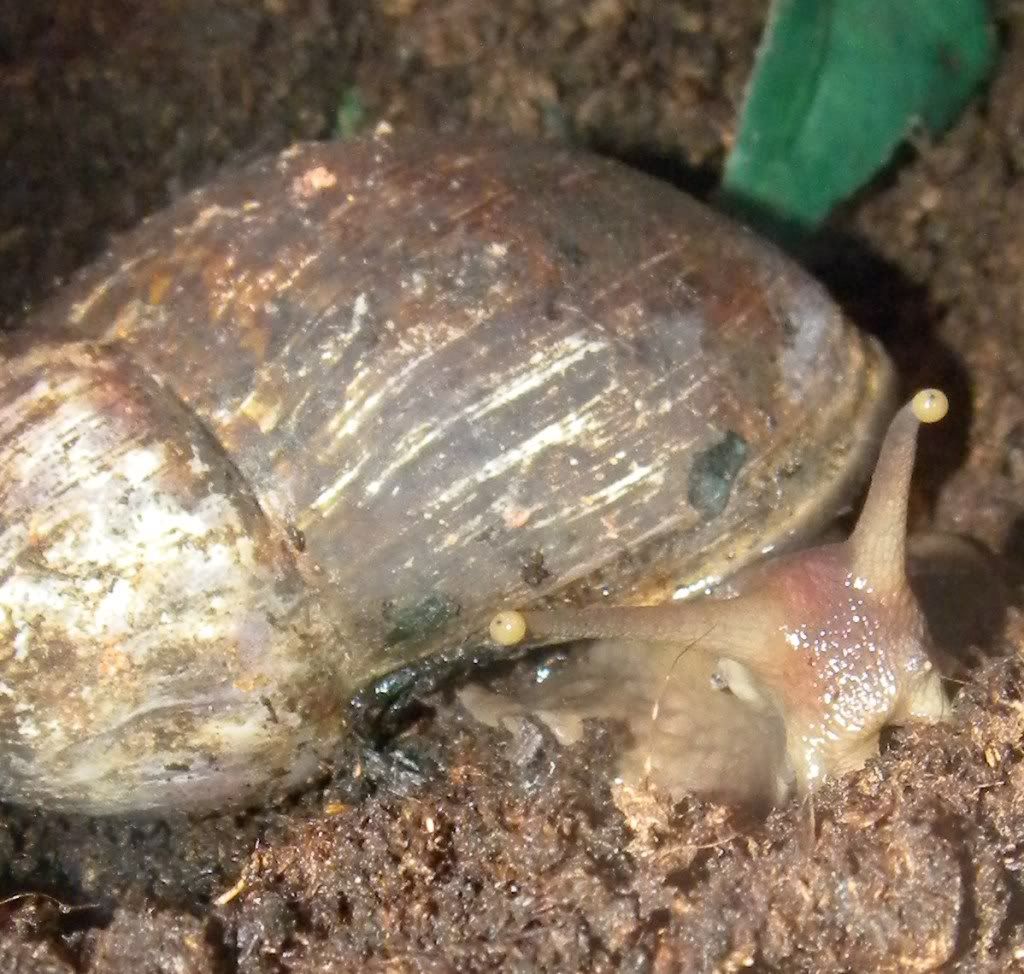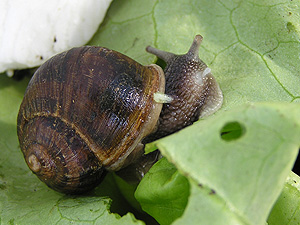|
|
Post by rosanna123 on Jul 30, 2010 21:15:41 GMT
i i need some help, one of my immac var. immac has had its dart out constant for the last weeks now, is it ok, i have never known it to stay out for this long and so i want to check he is ok Attachments:
|
|
|
|
Post by fabrizio on Jul 30, 2010 22:00:35 GMT
Hi Rosanna,
the picture is not very sharp, sadly... yet it seems that the everted part is the whole copulatory structure, not (just) the dart... It should appear as a thorn-like whitish structure; do you see it on there?
Some specimens at maturity have a more or less visible genital "papilla", yet I'd never seen such a degree of protrusion, and so long delayed in time.
Does it stay ever the same? Never retracted, even if at a little degree? Has the snail other companion to mate with, and did they actually mate?
-The love-dart is usually disposed of in most of the families, while (in some more primitive ones, as the Bradybaenidae ) it is re-utilized again and again, as it has been adscertained.
I don't know sadly, which "group" the Achatinidae family belongs to... but if the snail has actually such dart, it could be not "its own", too.
-If a snail bears such a dart "impaled" in its body tissues, that means it has received it from its mate; usually it shoud detach and fall, but I don't believe it would be something pathological if it remains there for a longer time.
-Love dart seems to serve to some hormone-delivering purpose, enabling a higher percentage of the sperms from the mate to survive within the "stabbed" snail's body, being spared a sort of tissutal "digestion".
You should chiefly verify the overall health condition of your snail: if it acts as normal, feed regularly etc, I believe there is not much matter for concerns.
Please let us know soon, how it becomes!
|
|
|
|
Post by rosanna123 on Jul 30, 2010 22:07:01 GMT
it stays the same all the time, in total i have 4 immac immacs in the same tank but i have never seen them mate, i will see if i can get some better pics
|
|
|
|
Post by rosanna123 on Jul 30, 2010 22:15:03 GMT
more pics Attachments:
|
|
|
|
Post by rosanna123 on Jul 30, 2010 22:16:27 GMT
sorry the pics are bad Attachments:
|
|
|
|
Post by rosanna123 on Jul 30, 2010 22:17:14 GMT
my camera is not very good Attachments:
|
|
|
|
Post by fabrizio on Jul 31, 2010 10:09:08 GMT
I can't see the dart, it seems to me it is a sort of prolapse, the sac being everted... this is normal, as a modification seen within copulatory behaviour; less so if it remains in such state, for so long time.. But do the snail behaviour normally, as its inmates?
|
|
|
|
Post by rosanna123 on Jul 31, 2010 10:11:51 GMT
yes it acts the same as all the rest
|
|
|
|
Post by Paul on Aug 1, 2010 15:16:29 GMT
I remember a long time ago, someone on here had a snail that such went about with it's penis protruding right out, to the length of the shell. It kept that up for at least a week without retracting it as I recall. The pictures of yours remind me of it, except that yours is more bunched up.
There's a good chance it's just desperate to breed and that it's not actually a health problem. My indicators of health have always been: Are they eating? Are they active? If the answer to both is a resounding yes, I don't think there's anything to worry about. In every afflication I've seen, appetite and activity are nearly always affected to some degree.
|
|
|
|
Post by Robert Nordsieck on Aug 3, 2010 19:20:03 GMT
Hi there, I also cannot see a love dart in this picture. Concerning the role of love darts in the mating of snails there are several interesting papers by Joris Koene displayed also on his homepage ww.jkoene.dds.nl. I especially like his fabulous electron microscope pictures of love darts. Achatinidae are not among the families that possess a love dart, see: en.wikipedia.org/wiki/Love_dart. The role of the love dart as an injection needle for the finger shaped glands' mucus and the meaning of that mucus during mating of the Roman snail is described here: Roman Snail: Mating and CopulationRoman Snail: The Genital Apparatus. Both are from weichtiere.at. Kind regards Robert |
|
|
|
Post by crossless on Aug 3, 2010 21:52:37 GMT
Here's picture when I first time in my life saw lovedart out on my Achatina Fulica. White thing is sexual organs, not dart.  |
|
|
|
Post by Robert Nordsieck on Aug 7, 2010 13:00:35 GMT
Hi there, induced by this discussion I wrote a new page on " the love dart" of terrestrial snails.  Brown garden snail ( Cornu aspersum) with two love darts in it's foot, of which one assumedly from Cepaea hortensis. Picture: Robert Nordsieck Happy to hear feed back. Kind regards Robert |
|
coyote
Archachatina papyracea
  Cochleas ego amo
Cochleas ego amo
Posts: 2,955
|
Post by coyote on Aug 7, 2010 20:43:29 GMT
Those electron microscope images of the love dart are amazing!
|
|
|
|
Post by ness on Aug 7, 2010 21:03:26 GMT
I have to admit - it makes me glad that I'm not a snail!  Fascinating article though. I'm impressed that you wrote that. I don't know enough on the subject to give feedback from a knowledgable point of view, however it is easy to understand and comprehensive, and I now know more than I did ten minutes ago!  . Is the page linked to your website? |
|
Deleted
Deleted Member
Posts: 0
|
Post by Deleted on Aug 23, 2010 15:07:39 GMT
My Fulica had that a week or two ago, I also think they're just them showin' their bits off!  |
|
|
|
Post by brunni on Oct 24, 2011 18:25:36 GMT
For almost 5 years Daniel Chung studied the courtship rituals involving the use of the "love darts" in Helix aspera. The following extracts are from his observations : "Love darts are calcareous spears that are thrust into the flesh of the mating partner during courtship and mating.
It has usually been assumed that the dart somehow "stimulates" the partner, though exactly what is stimulated or how this stimulation occurs has never been determined.
Perhaps the most puzzling thing about the dart is that it appears to harm the courting partner. It can be thrust entirely into the body of the partner and may lodge in the tissues of the foot, head, or other body parts. The partner often appears to be wounded and not "stimulated".
The dart of H. aspera can be almost 10mm long and has 4 vanes running down its axis ( see fig below ).
I have seen individuals darted in the mouth and head, with the the base and tip sticking out the opposite sides of the body.
In approximately 15% of the mating H. aspera, the dart is embedded entirely in the body of the snail, in about 25% the dart does not lodge very well and falls out."Ref : Hawaiian Shell News vol. XXXIV, n°. 5, pp 3-4. Attachments:
|
|
coyote
Archachatina papyracea
  Cochleas ego amo
Cochleas ego amo
Posts: 2,955
|
Post by coyote on Oct 24, 2011 23:03:21 GMT
". . . with the the base and tip sticking out the opposite sides of the body."
I wondered how often this happens. I imagine it must be a gruesome sight.
|
|